…thanks to West Bucktown Neighborhood Association and specifically the talented writer, Deborah Bottjer, for allowing me to share this info.
Upward Ground Vertical Gardens
They say the grass is always greener on the other side of the fence. But nothing could be further from the truth at the West Bucktown home of master gardener Kristina Risvold and Ron Forsythe, where “green” is as much a state of mind as it is a color.
The husband and wife duo recently launched Upward Ground Vertical Gardens, a start-up business dedicated to transforming small, urban outdoor areas into beautiful and beneficial green spaces. Not surprisingly, the idea for Upward Ground grew out of the couple’s own passion for sustainable, low–maintenance landscape design.
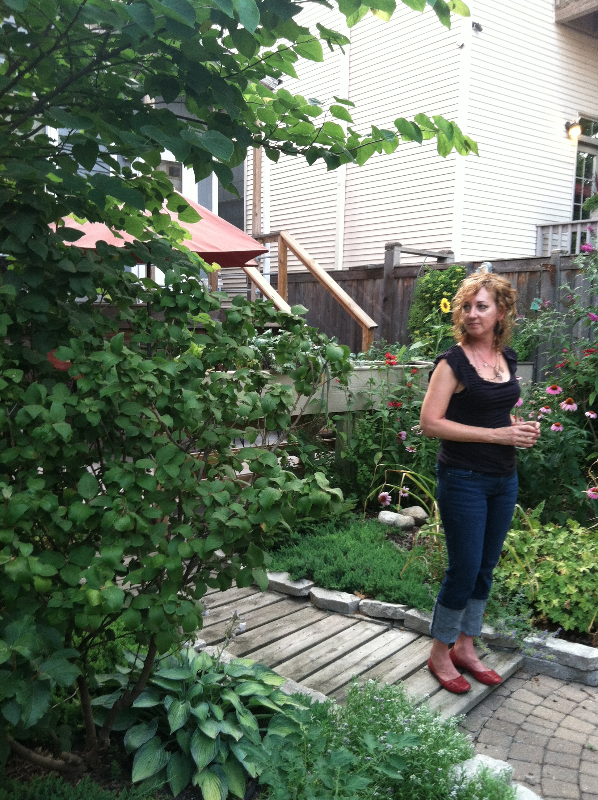 Many homeowners view the small patch of grass on a typical 25 x 125 city lot as something to covet. But not Kristina and Ron, who shunned the traditional “outdoor carpet” in favor of a lush mix of primarily native plants, flowers, herbs and vegetables. They designed and built their own custom planters to not only maximize their growing space and grow food free of pests and contaminants, but also to breathe new life into previously overlooked planting areas. Best of all, their garden takes just minutes a day to tend.
Many homeowners view the small patch of grass on a typical 25 x 125 city lot as something to covet. But not Kristina and Ron, who shunned the traditional “outdoor carpet” in favor of a lush mix of primarily native plants, flowers, herbs and vegetables. They designed and built their own custom planters to not only maximize their growing space and grow food free of pests and contaminants, but also to breathe new life into previously overlooked planting areas. Best of all, their garden takes just minutes a day to tend.
“Environmentally speaking, grass lawns aren’t actually all that green,” Kristina explains, pointing to the constant watering, mowing, fertilizing, and weeding required to keep them healthy and thriving. “I love my outdoor space and want to spend as much time as possible enjoying it, not slaving away and damaging the environment to maintain it.”
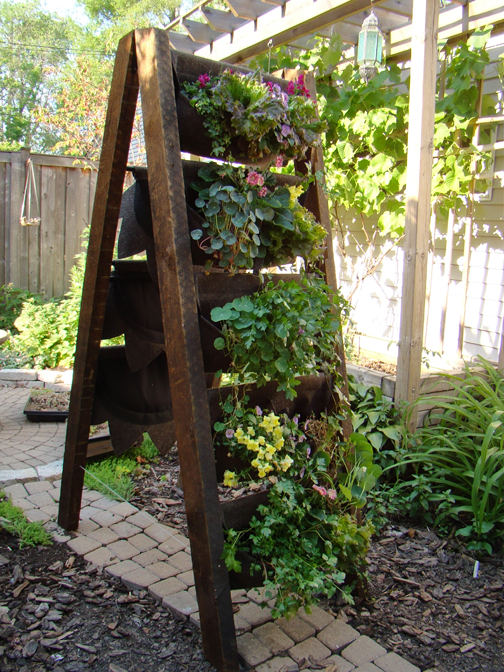 In designing the front and back yards of their Washtenaw St. home, Kristina took great care to select plants and flowers that would work well together and provide a succession of blooms and harvest from March through October. In the process, she became ever mindful of the little ecosystem she was creating that attracted birds, insects, butterflies….and bees. “Honeybees were a natural evolution in our garden,” she says. “Three years ago I built a hive for them, and we’ve been peacefully co-existing ever since!”
In designing the front and back yards of their Washtenaw St. home, Kristina took great care to select plants and flowers that would work well together and provide a succession of blooms and harvest from March through October. In the process, she became ever mindful of the little ecosystem she was creating that attracted birds, insects, butterflies….and bees. “Honeybees were a natural evolution in our garden,” she says. “Three years ago I built a hive for them, and we’ve been peacefully co-existing ever since!”
An artist by trade with a degree in the fine arts, Kristina has always had an eye for good design. But she is quick to credit her Grandma Jane for her green thumb. “She was my gateway to gardening,” Kristina explains. “On every visit, as long as the weather cooperated, we would be outside working with her plants. But as she got older, her mobility and flexibility became increasingly limited. So under her direction, I started doing more of the physical work myself.”
Kristina clearly listened well and learned a lot. “Gardening doesn’t have to be about getting down on your hands and knees and digging in the dirt,” she insists, noting that their dog Nalie’s passion for digging was what prompted the couple to explore out-of-the-ground gardening systems in the first place. “I just wish we had come up with these planters in my Grandma’s day – we could have greatly extended her interaction with her own garden.”
Both Kristina and Ron see gardens as living works of art limited only by the imagination, and they created Upward Ground to give even novicegardeners a way to bring their vision to life. With a product line that includes vertical plant ladders, whimsical felted hanging pouches, double‐sided saddlebag pouches (perfect for deck railings!) and hydroponic living walls, Upward Ground’s unique gardening solutions help make every inch of outdoor space count.
Kristina and Ron custom-make each of their products locally using timber from reclaimed sources, and they can tailor their designs to meet customers’ exact specifications. For example, their vertical plant ladder could also be constructed horizontally to accommodate small children or a gardener with limited mobility.
“Our planters can be used to grow many things, but we like to promote the idea of mixed-use planting,” notes Ron. “Combining edibles with flowers is a great way to enhance both the beauty and functionality of a garden.”
“We love being able to live in an urban environment and grow our own food,” echoes Kristina, noting that their annual backyard bounty of tomatoes, peppers, beets, raspberries, Swiss chard, grapes, and honey far exceeds what they can consume. (Lucky neighbors and friends reap the benefits of their over-harvest!) “We’re hoping that Upward Ground’s gardening systems will show people that growing fresh, great-tasting, organic produce and herbs in the city doesn’t have to bedifficult, expensive, or time-consuming.”
Upward Ground recently debuted at the Logan Square Farmer’s Market and Green Music Fest in Wicker Park. To learn more about their offering or to place an order, visit www.upwardground.com.
Turn that “S” Into “$$$” for Lucy Flower
Quick poll: Has anyone ever caught themselves adding an “S” to the Lucy Flower Park name, calling it Lucy FLOWERS instead?
Yeah, we thought so.
It’s okay, we’ve been guilty of this once or twice ourselves. It’s an honest and all-too-easy mistake to make. In fact, if we had a dollar for every time someone has done this, we’d be well on our way to raising the necessary funds for the planned renovation of Lucy Flower Park in 2013.
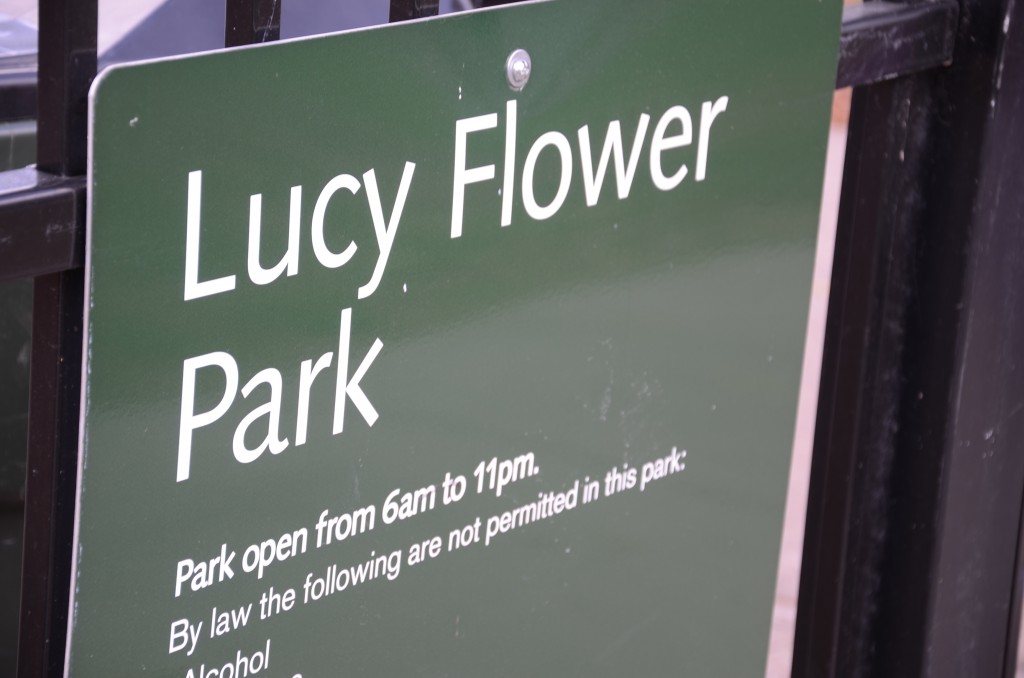 Thanks to persistent lobbying efforts of the Maplewood and Lucy Flower Parks Advisory Council (MLFPAC), the Chicago Parks District has agreed to foot the bill for $140,000 of the estimated $350,000 it will take to upgrade the park’s aging playground equipment (see below for project details). Another $140,000 will come from 1st Ward Alderman Joe Moreno, who has generously allocated a portion of his infrastructure menu funds over the next three years.
Thanks to persistent lobbying efforts of the Maplewood and Lucy Flower Parks Advisory Council (MLFPAC), the Chicago Parks District has agreed to foot the bill for $140,000 of the estimated $350,000 it will take to upgrade the park’s aging playground equipment (see below for project details). Another $140,000 will come from 1st Ward Alderman Joe Moreno, who has generously allocated a portion of his infrastructure menu funds over the next three years.
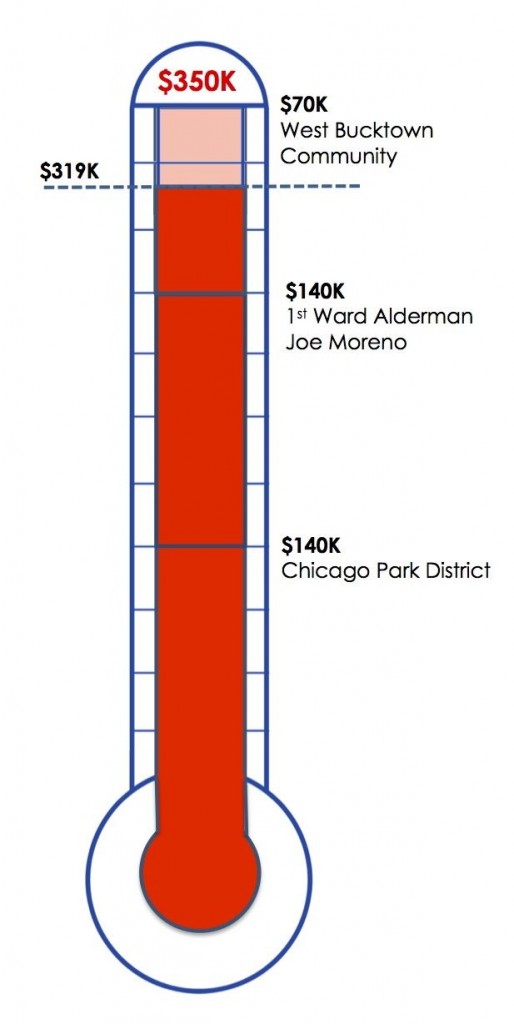 “I’m incredibly happy to help the neighbors around Lucy Flower Park, who are relentless allies in our never-ending effort to improve the community,” said Moreno. “I’m confident the remaining funds can be raised by utilizing the talent and generosity already demonstrated by the people from this part of the 1st Ward.”
“I’m incredibly happy to help the neighbors around Lucy Flower Park, who are relentless allies in our never-ending effort to improve the community,” said Moreno. “I’m confident the remaining funds can be raised by utilizing the talent and generosity already demonstrated by the people from this part of the 1st Ward.”
So that leaves the West Bucktown community responsible for about $70,000. Fortunately, MLFPAC already has more than $38,000 in its coffers, thanks to previous fundraising efforts and community donations. Still, covering the shortfall of $32,000 will be a challenging undertaking for the neighborhood.
“We are looking at the renovation of Lucy Flower as an important investment in the safety and well-being of our children,” emphasizes Diana Olivar, MLFPAC member and a driving force behind the renovation project. “Thriving parks and playgrounds are the backbone of strong communities.”
Here’s how you can help:
Attend a fundraising event. The recent pizza-and-beer party at West On North raised just over $1,000 in the first of what will be many upcoming opportunities for us to come together as neighbors and friends to support the renovation project. (A special shout-out is in order for Joe and Laurie Sabath of West On North, who not only contributed pizza, beer, and raffle gift certificates, but also made a very generous personal donation!) Other planned fundraisers include the July 14th Yard Sale at Maplewood Park, a neighborhood block party in August, the annual MLFPAC fundraiser at Naveen’s Cuisine in November, and a Circus In The Park event next summer.
Participate in the “Buy A Brick” program. Details are still being ironed out, but residents and area businesses will be given the chance to inscribe their names (or the name of someone they want to honor) on brick pavers used in the park. Want something even more high profile? Email us at environmental@westbucktown.org about other sponsorship opportunities, such as benches, planters, bike racks, and trees.
Make a donation. Nothing will get us to our goal quicker than good ol’ cash! Consider this…if every household in the neighborhood was able to kick in just $10, we would be more than halfway to our goal in no time. But no matter how large or small, every contribution puts us a step closer to a new and improved Lucy Flower Park. Your tax-deductible donation can be made via PayPal – click here to be redirected to the WBNA website.
Our Hidden Gem Will Really Shine!
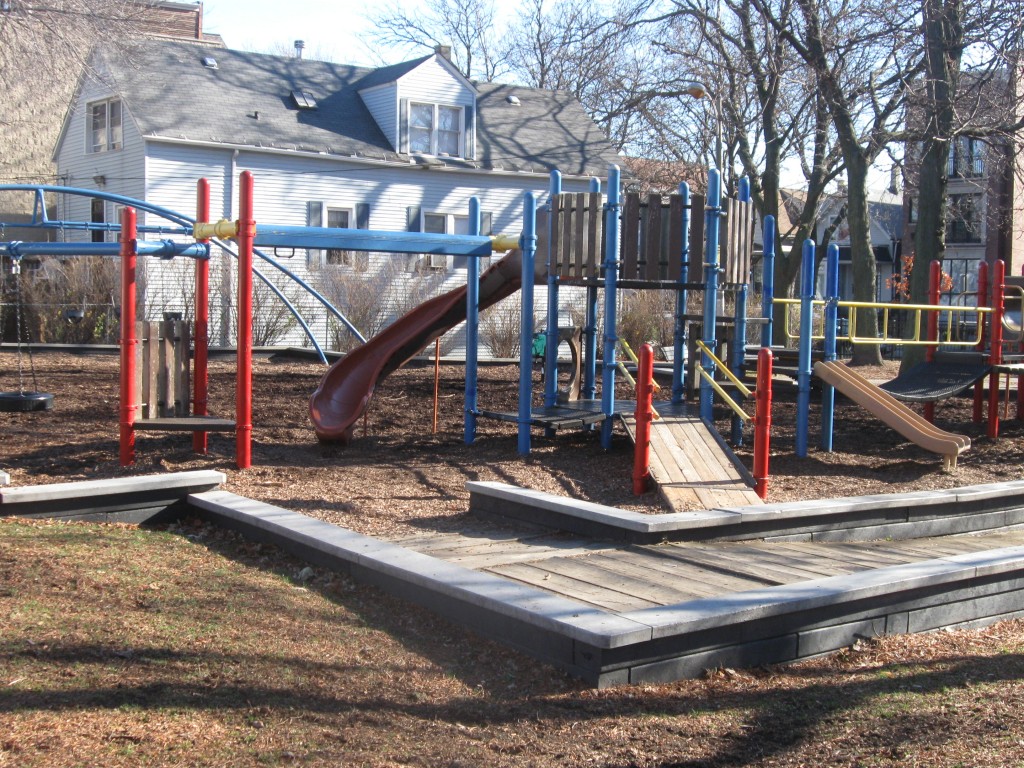 Much smaller in size and with none of the Park District programs of its big sister, Maplewood Park, Lucy Flower has long been considered the “hidden gem” of West Bucktown. That’s because what it lacks in square footage and organized activity, it more than makes up for with mature trees, plenty of summertime shade, and an intimate setting that makes it particularly attractive to families with small children. What’s more, in the last two years, the park has received grant money for raised beds and planter boxes, upgraded the water supply, and hosted a free Children’s Garden Club every other Saturday during the summer months.
Much smaller in size and with none of the Park District programs of its big sister, Maplewood Park, Lucy Flower has long been considered the “hidden gem” of West Bucktown. That’s because what it lacks in square footage and organized activity, it more than makes up for with mature trees, plenty of summertime shade, and an intimate setting that makes it particularly attractive to families with small children. What’s more, in the last two years, the park has received grant money for raised beds and planter boxes, upgraded the water supply, and hosted a free Children’s Garden Club every other Saturday during the summer months.
But despite this progress, according to a recent article in TimeOut Kids Chicago, Lucy Flower is among the 37% of Chicago Park District playgrounds that fall short of meeting national safety standards. During the most recent 2010 survey conducted by the Injury Prevention and Research Center of Children’s Memorial Hospital, a team of trained safety inspectors visited 477 playgrounds and graded them in four areas: age-appropriateness of equipment, soft-surfacing near play areas, equipment maintenance, and the overall physical layout of the space. Lucy Flower received a score of 58% – well below the 70% needed to meet national safety standards. In comparison, Maplewood Park (which was renovated in 2007) scored a respectable 84%.
Not surprisingly, one of the biggest safety issues at Lucy Flower is the use of wood chips in the playground area. Not only are the chips dirty and unsanitary, they are also not as shock absorbent as newer surfaces made from rubber or rubber-like materials. And that translates into a potential for more injured children.
The preliminary renovation plan for Lucy Flower is still being refined, but it is expected to feature:
Installation of a soft, safety-tested surface
Modern playground equipment with age-appropriate features, such as climbing nets and ramps for older children, and slides and tunnels for toddlers
New benches
Updated fencing around the flower beds
While not included in the initial plan, there has also been discussion about installing some sort of water feature at Lucy Flower. Normally, this kind of enhancement would add upwards of $100,000 to the project estimate. However, the Park District is looking into ways to make the projected $350,000 stretch to cover a water feature, as well. We expect to hear more about the feasibility of this request in coming weeks and will keep everyone posted on the progress.
Do a Little Good for the ‘Hood!
Take a walk through West Bucktown and you’ll see a fabulous mix of landscapes and gardens. There’s clearly no cookie-cutter approach to gardening in our little neck of the woods, and that’s a big part of what makes this community so diverse and wonderful.
 Everyone wants to live in a neighborhood that looks neat and well cared for, which is why we’re asking all West Bucktowners to take a few moments to survey their block and identify any areas that could use a little extra TLC. There’s nothing like “neighbor helping neighbor” to help build a sense of camaraderie and pride in West Bucktown.
Everyone wants to live in a neighborhood that looks neat and well cared for, which is why we’re asking all West Bucktowners to take a few moments to survey their block and identify any areas that could use a little extra TLC. There’s nothing like “neighbor helping neighbor” to help build a sense of camaraderie and pride in West Bucktown.
(Of course, if there’s a problem property on your block that you can’t resolve on your own, by all means, email us at info@westbucktown.org and we’ll see what we can do to help.)
To get you started, here are a few “cheap and chic” ways you can spruce up a parkway, vacant lot, or forlorn little plot on your block:
Don’t stop at your property line! If you already have the lawnmower out, it only takes an extra 5 minutes to mow your neighbor’s parkway or front lawn, too. Elderly residents and absentee landlords will appreciate it!
Plant some seeds! If grass isn’t your thing, you can spend $3 on seeds at the local garden center and plant a few perennials (think “permanent”) that will come back every year. Cosmos do especially well in our area and provide a great splash of color. Or, if you’re just not ready to commit to a long-term relationship with your garden, Nasturtiums are a fun and pretty annual, especially for children. The leaves look like lilypads, or shields, and the flowers resemble little helmets.
Go wild! Vacant lots and parkways don’t have to be an eyesore of overgrown grass and weeds — turn them into fields of blooming color with a handful of wildflower seeds. The WBNA has distributed seeds at our last few Clean-and-Green events — email us at environmental@westbucktown.org if you’d like a packet or two.
Get creative! Look around at what your neighbors have planted and try to work within their color palate, share some plants, or extend a plot to meet another one (particularly on the parkways). You’d be amazed at what a difference a little time and love can make!
Ask the Alderman
In this issue of the WindowBox, we hit up 1st Ward Alderman Joe Moreno with a few pertinent parkway questions:
Q: Do I need “permission” to mow or maintain a parkway in front of a vacant property, or in front of a negligent neighbor’s house?
A: No. However it is up to the property owner to maintain the parkway in front of there property regardless of whether or not it is vacant
Q: Can I prune back the branches of a parkway tree that’s in front of my own property?
A: Not without a permit. Permits must be obtained from the Bureau of Forestry, (312) 746-5254.
Q: Does the city have any guidelines/ordinances about a homeowner’s responsibility for maintaining the parkway? Can fines be levied if a parkway is allowed to become grossly overgrown?
A. Yes. According to Ordinance 10-32-050, the owner of a property immediately adjacent to a parkway is responsible for maintaining it in good condition, including weeding and/or mowing.Fines can be levied by our Streets and Sanitation Ward Yard Superintendent Manny Gonzalez.
Q: If the city digs up a parkway for water/sewer/gas repairs, are they required to fix the grass or landscaping when they’re done?
A: They are only required to restore by filling in the parkway. They are not responsible for any landscaping or decorations.
Q: If the roots from a parkway tree cause damage to the sidewalk in front of my house, who is responsible for repairs?
A: The city is, but normally such repairs are paid for through either the shared cost sidewalk program (also know as the 50/50 program) or from my annual aldermanic infrastructure menu fund.








